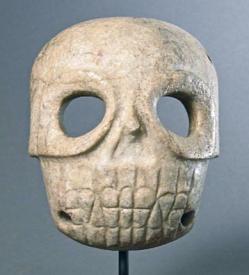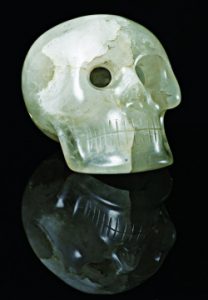In the mid 1800’s Crystal skulls began to circulate, some even finding their way into museums – claiming to be made by pre-Columbian peoples. Although these allegedly magical artifacts raised suspicion among historians and archaeologists for almost a century, they remained in museum collections. However, in 1992 one notable example, The Smithsonian Skull, was donated anonymously to the British Museum, and this event finally moved American and British archaeologists to begin research that led to the debunking of these mysterious artifacts.
Though the Smithsonian Skull was donated anonymously, many other similar crystal skulls were traced back to the 19th century French antiquity dealer, Eugene Boban. Boban had sold the skulls to art dealers claiming they were ancient aztec artifacts, exploiting the imagination of the ignorant buyers. With this forged pre-Columbian provenance, the skulls found their way into both the British Museum and The Quai Branly Museum in Paris.
As research on these skulls commenced, the initial evidence of falsification was the fact that the Smithsonian skull had come from an undocumented site. Furthermore, as crystal can not be carbon dated, no absolute dating method had ever been used to test the authenticity of the skulls. However, archaeologists used relative dating to compare the style of real Aztec skull symbolism to the crystal skulls, and a discrepancy was found in representation of teeth. In the crystal skulls, teeth had been created in linear, symmetrical rows – unlike the more natural pattern of the Aztec designs. Archaeologists also used relative dating methods to compare surface etchings. On the surface of an authentic, Aztec, crystal goblet, etchings showed variance – signs of a handcrafted object. However, the crystal skull etchings showed the use of a rotary wheel, which was only introduced after the Spanish Conquest. The relative date Archaeologists had begun to consider of at least the late 1500’s, was then cross checked using an X-ray diffraction system. The researchers found leftover residue of silicon carbide: an abrasive material used for smoothing in stone carving workshops beginning in the 20th century. Lastly, iron-rich chlorite mineral traces that were found in the crystal of the skull suggested that the crystal material wasn’t even naturally occurring in the Yucatan region, but rather from Brazil or Madagascar.
The story of the Smithsonian Skull highlights the importance of empiricism in archaeology. Though Babon did sell fake artifacts, he had also traded real ones – making it likely that he knew he was selling forges, but let his personal bias and motivations for profit allow him to look past this. On the other hand, British and American researchers had to look past their own possible, natural biases in order to question the authenticity of the crystal skulls – which up to this point had been ignorantly assumed to be pre-Columbian. Lastly, this series of events shows the importance of the use of multiple dating methods to cross check, and how relative dating can become crucial in artifacts that do not allow absolute dating methods.
Work Cited
“Ancient Costa Rica Stone Underworld Skull Deity Death Mask.” Busacca Gallery , www.busaccagallery.com/catalog.php?catid=157&itemid=6383.
Everts, Sarah. “Crystal Skulls Deemed Fake.” CEN RSS, American Chemical Society, 4 Mar. 2013, https://cen.acs.org/articles/91/i9/Crystal-Skulls-Deemed-Fake.html
“Is This Crystal Skull Really Ancient?” Smithsonian.com, Smithsonian Institution, www.smithsonianmag.com/videos/category/history/a-real-crystal-skull/.
“The Smithsonian Skull .” Chemical and Engineering News , https://cen.acs.org/articles/91/i9/Crystal-Skulls-Deemed-Fake.html
Additional Content
https://anthropology.si.edu/crystal_skulls/
http://www.britishmuseum.org/research/news/studying_the_crystal_skull.aspx



Bias is a problem when doing any type of research, especially when dealing with/thinking about human participants. Faking of artifacts is faking of data, which is very serious in the academy. How should we deal with those who fake artifacts? It technically isn’t a crime I don’t think, but what should we do to such a serious offense? What have they done in the past in such cases?
When considering what steps to take and what steps have already been taken against fake archaeology, one should look to the case of Japanese archaeologist Shinichi Fujimura. Fujimura began working in archaeology in Japan in the 1970’s, but it wasn’t until the 1990’s that his work began to arouse suspicion (Anonymous Swiss Collector). Fujimura was caught and photographed inserting his own personal collection of artifacts into lower levels of strata – skewing research on the Japanese paleolithic period. Although no legal steps were taken against the archaeologists, the photos were published in Japanese newspapers, marring his reputation as a scientist and ending his career. Furthermore, all of Fujimura’s work was taken out of museums and devalued – though he claimed some of it was truly authentic. This case of archaeological fraud also lead to the scrutinizing of other Japanese archaeological research on the paleolithic period. This scrutiny suggested forgery in the work of another Japanese archaeologist, Mitsuo Kagawa, who despite accusation claimed to be innocent. Kagawa’s condemnation eventually lead to his suicide, which then prompted his family to successfully sue the newspaper that had originally tainted his name and work (Anonymous Swiss Collector).
It is the complexity of this event with the possibly false criticism of Kagawa through the forgery of Fujimura, that makes this case so useful in analyzing ways of dealing with faked archaeology. It shows us that although one should investigate archaeologists who seem to be faking their research, as many a times it may be true, one must also be careful as the stake of the accusation is extremely high. In a profession where scientists pride themselves on their ability to produce authentic and accurate work, false accusations against their validity can destroy careers and stability. I believe that people should continue to investigate false archaeology but with caution and sensitivity – though it can also be argued that estimating the mental stability of the accused is not the responsibility of the general public when denounce his credibility.
Work Cited
“Anonymous Swiss Collector.” Faking the Past: When Archaeologists Commit Fraud, Oct. 2014, http://www.anonymousswisscollector.com/2014/10/faking-the-past-when-archaeologists-manufacture-illicit-antiquities.html.